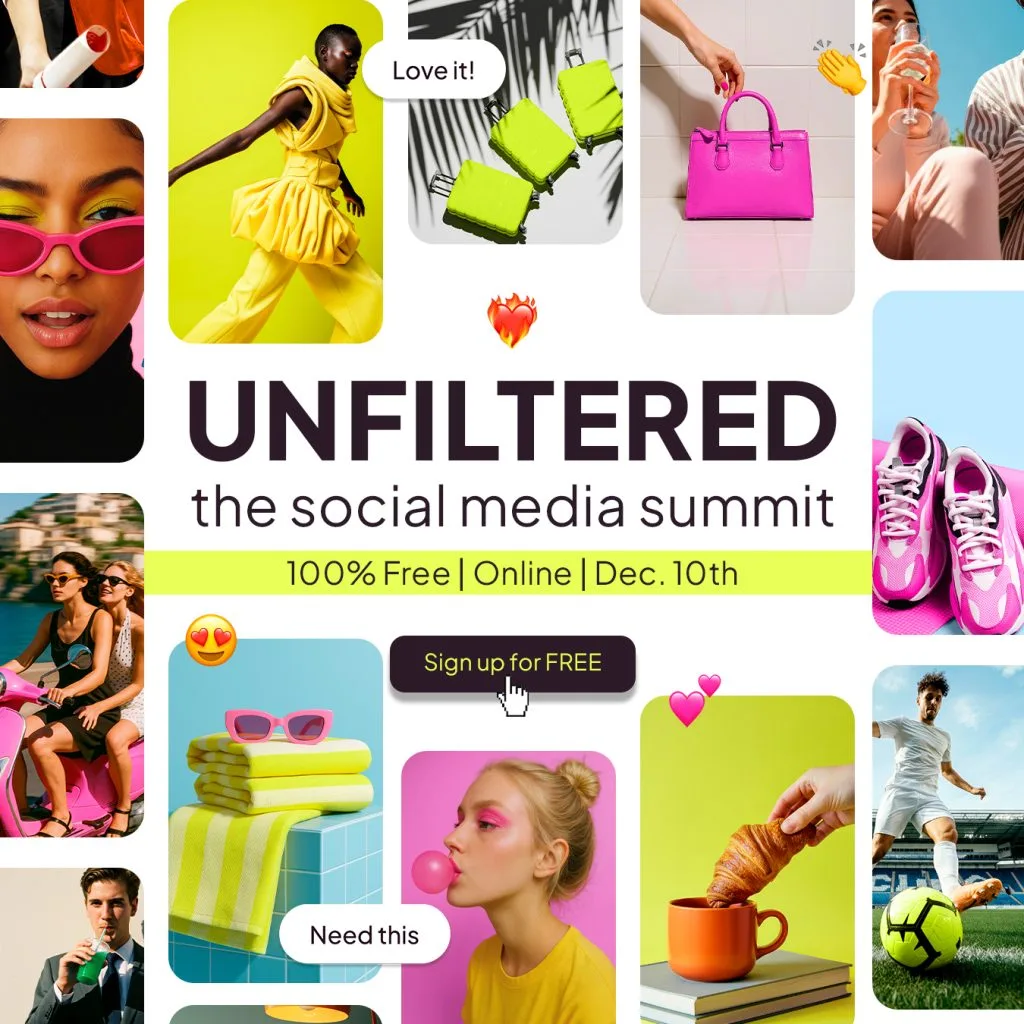Micro Content in Marketing: What It Is and How to Use It

Micro content has become one of the most reliable ways to grab attention online. It’s short, quick to consume, and designed to spark curiosity. Think of it as the bite-sized version of your marketing. It’s something people can engage with in seconds before moving on to explore your longer content, products, or services.
These quick pieces of content are perfect for cutting through the noise of crowded feeds. A single short video, headline, or graphic can stick with your audience far longer than a lengthy post they don’t have time to finish.
What is Micro Content?
The term “micro content” might not be something you hear every day, but it has become a regular part of how we interact on social media.
Micro content is any short piece of content that people can consume quickly. It could be a line of text, a quick image, or a short video, usually under 30 seconds. When the idea first appeared, it mostly referred to things like headlines, email subject lines, or small snippets meant to catch attention and encourage people to read the full article.
Today, micro content has grown well beyond that. It includes a variety of formats designed to grab attention quickly and be easy to share, such as:
- Email subject lines and preview text
- Tweets/X posts and LinkedIn updates
- Instagram Reels, Stories, and carousels
- TikTok clips
- YouTube Shorts
- GIFs, memes, and quick infographic snippets
- Headlines and meta descriptions for SEO
- Product teasers, pull quotes, and statistics
The shift toward shorter formats is tied to the way people consume content online. Attention spans are shorter, feeds move fast, and platforms reward content that gets people to stop scrolling for a few seconds. This is where micro content shines.
Almost every major platform has its own version of micro content. Here are the main ones to focus on in 2025:
- Instagram: Reels, Stories, carousel posts
- TikTok: Short, creative videos designed to entertain or inform
- X (Twitter): Fast updates, reactions, and conversations
- Facebook: Short posts, Reels, and Stories
- LinkedIn: Bite-sized professional updates or quick insights
- YouTube Shorts: Vertical videos under one minute
- Snapchat: Stories and quick snaps
- Pinterest: Visual snippets, idea pins, and infographics
- Emerging platforms like Lemon8, Substack Notes, and Trend.io that put user-generated content front and center
Micro content has moved from being just a supporting detail (like a headline) to becoming the main way people interact with brands online. It’s often the first thing someone sees from you, and it can be the spark that leads them to explore your bigger pieces of content.
Types of Micro Content
Micro content does not follow one set formula. It can take many shapes depending on the platform you are using and the goal you want to achieve. The common thread is that it can be consumed quickly, usually in 30 seconds or less.
Here are some of the most popular types you will see across social media and digital marketing:
- Social Media Posts with Visuals and Links: Short updates paired with an image, video, or link that encourage fast interaction and keep your audience engaged.
- Short-Form Videos: TikToks, Instagram Reels, or YouTube Shorts that deliver a clear message, tip, or story in just a few seconds.
- Email Subject Lines and Preview Text: Brief phrases designed to capture attention and convince readers to open your emails.
- Headlines and Meta Descriptions: Snippets crafted to attract clicks from search results while summarizing your content.
- GIFs and Memes: Fun, shareable content that shows your brand’s personality and encourages social interaction.
- Infographic Fragments: Small sections of a larger visual that highlight a single fact or statistic in a digestible format.
- Quick CTAs: Short prompts like “Sign up today” or “Watch now” that guide users toward the next step.
- Pull Quotes or Data Points: Single insights, quotes, or stats taken from longer content, making them easy to share.
- Product Teasers and Behind-the-Scenes: Quick glimpses that spark curiosity and make your brand feel more approachable and real.
The variety here is what makes micro content so powerful. A single blog post or video can be broken down into multiple formats: a headline for search, a stat for LinkedIn, a quote graphic for Instagram, and a short clip for TikTok. Each piece may be small on its own, but together they keep your brand present across different platforms and touchpoints.
Why Micro Content Works for Brands
The real strength of micro content is how naturally it fits into the way people use social media. Most users are scrolling quickly, checking their phones between tasks, or looking for something that gives value in a matter of seconds. Micro content meets that need while helping brands stay visible and memorable.
Here are some of the biggest benefits of micro content:
- More Visibility: Quick, shareable snippets reach a wider audience and keep your brand top of mind.
- Higher Engagement: Short posts and videos match today’s fast attention spans and often generate more interactions than longer content.
- Better Recall: When your branding is consistent across platforms, people are more likely to remember you later.
- Visual Appeal: An eye-catching graphic or 10-second video can stop someone mid-scroll in a way that a block of text rarely does.
- Simple Tracking: These smaller pieces are easy to test, measure, and refine based on how your audience reacts.
- Traffic and Conversions: A quick teaser or statistic can spark enough interest to send people to your blog, sign-up page, or online store.
- Efficient Content Creation: A single long-form piece, like a webinar or podcast, can be repurposed into many smaller posts. That one asset might turn into a set of TikTok clips, an Instagram carousel, a few Stories, and a LinkedIn update.
Tips for Creating a Micro Content Strategy
The easiest way to start using micro content strategically is by looking at what you already have. Find all the ways you can pull out the most interesting, valuable, or entertaining moments. From there, you can repurpose, test, and share across multiple platforms without doubling your workload.
- Repurpose Long-Form Content: Break down a webinar into short clips, turn a blog post into stat graphics, or pull a quote from a podcast to share on social media. Each piece can be shared as a standalone post to attract attention and drive people back to the full content.
- Keep Your Feeds Active: Share consistent snippets that point back to your website, blog, or other long-form resources to continuously drive traffic.
- Experiment: A few words in an email subject line, CTA, or caption can be the difference between someone clicking or scrolling past. Use A/B testing to see what works and what doesn’t.
- Highlight UGC: User-generated content like authentic reviews, testimonials, or customer photos build trust and show that people are already engaging with your brand.
- Use Micro Content in Ads: Short videos or visuals tend to capture attention faster than long creatives, making them great for campaigns.
- Strengthen Your Search Presence: Write headlines and meta descriptions that not only summarize your content but also spark curiosity and encourage clicks.
- Put the Most Important Detail First: Since micro content is consumed quickly, lead with the information that matters most in your video, headline, or caption.
- Know Your Audience Well: Knowing your audience’s interests, challenges, and habits helps you create micro content that connects immediately. When your content addresses a pain point or curiosity, it is more likely to engage.
Using Metricool to Make Micro Content Work Harder
Creating micro content is only the start. To make it truly work for your brand, you need a way to plan, post, and measure results across all your channels. Metricool makes managing every part of your micro content strategy simple and practical.
- Plan and Schedule Across Platforms: With Metricool, you can schedule posts for Instagram, TikTok, X, LinkedIn, Facebook, YouTube Shorts, and more. The visual content calendar shows everything at a glance, helping you keep a consistent presence and spot gaps in your posting schedule.
- Best Times to Post Data: Metricool shows when your followers are online and most likely to engage. That way, your micro content lands at the right time, so it’s more likely to be seen, clicked, and shared.
- Generate Content Ideas with AI: Stuck for what to post? The AI content generator can create posts based on the platform and tone you choose. You can produce short captions, Tweets/X updates, or quick video scripts that match your audience and style.
- Repurpose Content Quickly: If a post is performing well, the repurpose button lets you share it across other channels in seconds. One successful piece can turn into several opportunities to engage new viewers.
- Measure Performance: Metricool’s analytics and reporting show how your micro content is performing. You can track clicks, engagement, and conversions, then use that information to plan what to share next.
With Metricool, micro content becomes more than just short, fun posts. It helps your audience discover your brand, keeps them engaged, and drives traffic to your longer content. By making planning, posting, and reviewing easier, Metricool turns small pieces of content into a consistent, effective part of your marketing strategy.


